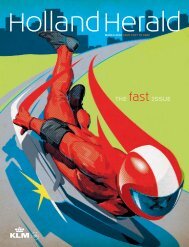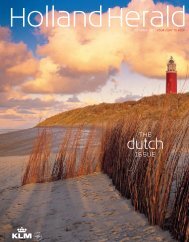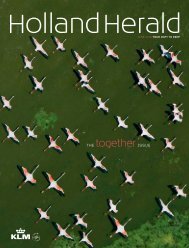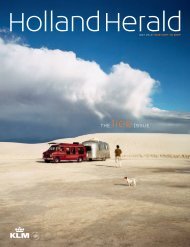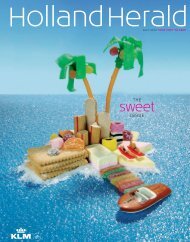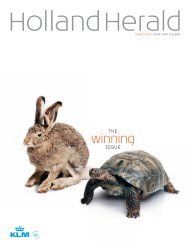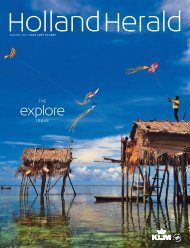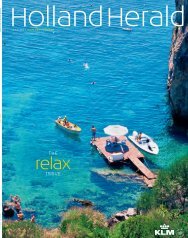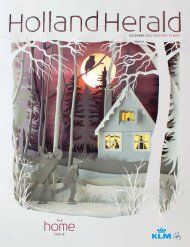january-2010
january-2010
january-2010
Create successful ePaper yourself
Turn your PDF publications into a flip-book with our unique Google optimized e-Paper software.
Paws for thought<br />
POLAR BEARS FORAGE FURTHER FOR FOOD<br />
KLM’s daily workplace is a world full of<br />
natural beauty, and rich in diversity. To<br />
help sustain and protect the (sometimes<br />
fragile) biodiversity in the destinations<br />
to which it fl ies, the airline has set up a<br />
programme called Destination Nature<br />
to support and actively encourage the<br />
conservation objectives of projects and<br />
environmental organisations, such as<br />
the World Wide Fund for Nature (WWF).<br />
Through WWF’s Dutch branch (Wereld<br />
Natuur Fonds, or WNF), KLM endorses and<br />
promotes WWF ventures worldwide, from<br />
marine reserve protection in Kenya to river<br />
basin revitalisation in China.<br />
Pole position<br />
The Arctic is among the regions where the<br />
WWF is active. It is also where the effects<br />
of climate change are felt more keenly<br />
than anywhere else on earth. Of particular<br />
concern is the rate at which sea ice is<br />
melting and how this is affecting the daily<br />
life cycle, and ultimate survival, of one of<br />
the region’s indigenous inhabitants – the<br />
polar bear.<br />
Sea ice is the polar bear’s natural<br />
habitat. It is where they hunt for food –<br />
mainly seals. Any reduction in the ice<br />
has serious knock-on effects for the<br />
animal’s daily round. Because sea ice is<br />
now thawing sooner and freezing later<br />
in the year, polar bears have to forage<br />
further for food, and have less time to build<br />
up valuable energy and stored fats for<br />
themselves and their cubs.<br />
Monitoring by the WWF has also<br />
indicated other noticeable behavioural<br />
shifts, including lower reproductive and<br />
ARCTIC TEMPERATURES ARE RISING<br />
KLM DESTINATION NATURE<br />
growth rates, lower adult survival, altered<br />
movement and den areas, increased bearhuman<br />
interactions, and a reduction in<br />
population size.<br />
In the fi eld<br />
As well as deploying fi eld workers to<br />
collect data and information in the Arctic<br />
region, WWF supports long-term research<br />
by organisations such as the Norwegian<br />
Polar Institute into the effects of climate<br />
change on polar bears and sea ice in<br />
Spitsbergen and Svalbard. This includes<br />
‘tracking’ polar bears using GPS transmitters<br />
– an activity which everyone can follow on<br />
the WWF website www.panda.org.<br />
“Higher temperatures are having a<br />
direct effect not only on polar bears in<br />
Hudson Bay, but on populations across<br />
the Arctic,” says Geoff York, Polar Bear<br />
“Any reduction in the<br />
ice has serious<br />
knock-on effects”<br />
Conservation Coordinator for WWF’s<br />
International Arctic Programme. “It is<br />
important people realise that it is not too<br />
late to reverse these trends.”<br />
For more information on WWF’s activities<br />
in the Arctic, and elsewhere, visit<br />
www.panda.org. Details about KLM’s<br />
Destination Nature programme can be<br />
found on www.klm.com/csr – scroll down<br />
under ‘The Community’.<br />
See also ‘Keeping it cool’, pages 32-38,<br />
for some stunning photography by<br />
Jan Vermeer, taken in both Arctic and<br />
Antarctic regions.<br />
Holland Herald TRAVELLERS CHECK 87



